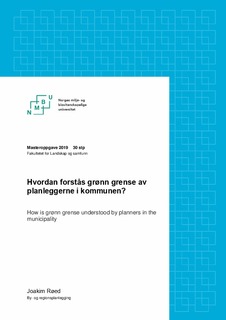| dc.contributor.advisor | Movik, Synne | |
| dc.contributor.author | Røed, Joakim | |
| dc.date.accessioned | 2019-08-12T12:52:08Z | |
| dc.date.available | 2019-08-12T12:52:08Z | |
| dc.date.issued | 2019 | |
| dc.identifier.uri | http://hdl.handle.net/11250/2607958 | |
| dc.description.abstract | Regional plan for Oslo og Akershus ble vedtatt desember 2015. En av retningslinjene i planen er at kommunene skal etablere en langsiktig grønn grense for prioriterte vekstområder. Grensen skal defineres i kommuneplanens arealdel og skal si noe om ønsket utvikling av stedet. Innenfor grensen skal vekst gå foran vern, mens utenfor skal vern gå foran vekst.
Denne oppgaven handlet om å se på hvordan grønn grense fra den regionale planen har blitt forstått hos planleggerne i kommunen. Dette ble gjort ved å undersøke Sørums og Eidsvolls arbeid med grønn grense. Problemstilling for arbeidet har vært; hvordan forstås grønn grense av planleggerne i kommunen? For å svare på problemstillingen har det også blitt utformet underproblemstillinger.
For å kaste lys over problemstillingen har det blitt gjennomført fem dybdeintervjuer, to med planleggere fra kommunen, et med person ansatt i Akershus fylkeskommune, et med person som var med på å utarbeide Regional plan for Oslo og Akershus, og et med person ansatt i Norges Bondelag.
Dokumentstudien og intervjuene ga informasjon om at begrepet grønn grense hadde vært vanskelig for kommunen å forstå og bruke slik den regionale planen la til grunn.
Resultatene fra dokumentstudien og intervjuene forteller at samordning over flere nivåer er utfordrende og begreper som defineres på et nivå ikke alltid lett kan overføres til et annet. Dette har medført at utgangspunktet til kommunene har vært feil ut fra regional myndigheters hensikt bak grensen. Dermed har kommune måtte gjøre endringer på sine grenser i løpet av arbeidet. | nb_NO |
| dc.description.abstract | Regional plan for Oslo and Akershus was adopted in December 2015. One of the guidelines in the plan is that the municipalities are to establish a long-term green border for their prioritized growth areas. The plan says that the boundary must be defined in the municipal area plan. The green border is to define something about their desired development of the prioritezed growth areas. The guidelines say that within the boundary, growth is prioritized, while outside, protection should be prioritized ahead of growth.
This thesis wants to investigate how green boundaries from the regional plan have been understood by the planners in the municipality. This was done by examining Sørum's and Eidsvoll's work with green border. The research question for the work has been; What does the green boundary of planners mean in the municipality? In order to respond to the problem, there have also been developed subproblems.
For this purpose, five depth interviews have been conducted, two with planners from the municipality, one with a staff member in Akershus Fylkeskommune, one with people involved in make the Regional plan for Oslo and Akershus, and one person employed at Norges Bondelag.
The document study and the interviews gave information that the concept of green border was difficult for the municipality to understand and use the regional plan.
The results of the document study and the interviews say that co-ordination across several levels is challenging and concepts that are defined at a level cannot always easily be transferred to another. This has meant that the starting point for the municipalities has been wrong based on the regional authorities' intention behind the border. Thus, the municipality must make changes on its borders during the work with the plan. | nb_NO |
| dc.language.iso | nob | nb_NO |
| dc.publisher | Norwegian University of Life Sciences, Ås | nb_NO |
| dc.rights | Navngivelse 4.0 Internasjonal | * |
| dc.rights.uri | http://creativecommons.org/licenses/by/4.0/deed.no | * |
| dc.subject | Grønn grense | nb_NO |
| dc.subject | Flernivåstyring | nb_NO |
| dc.title | Hvordan forstås grønn grense av planleggerne i kommunen? | nb_NO |
| dc.title.alternative | How is "grønn grense" understood by planners in the municipality? | nb_NO |
| dc.type | Master thesis | nb_NO |
| dc.description.version | submittedVersion | nb_NO |
| dc.subject.nsi | VDP::Samfunnsvitenskap: 200::Urbanisme og fysisk planlegging: 230::Romlig, territoriell planlegging: 238 | nb_NO |
| dc.description.localcode | M-BYREG | nb_NO |

